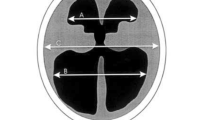Abstract
Object
The authors present the difference of shortening the ventricular shunt catheter associated with growth of the cranium between the frontal and parieto-occipital access, a key for long patency of the shunt implanted in children.
Materials and method
Our retrospective study included 28 children. In group A (n = 9), the catheter was inserted through a frontal burr hole and in group B (n = 19), through a parieto-occipital burr hole. To compare changes that occurred in the interval between the time of insertion and follow-up in the length of the ventricular catheter in the cranium and to assess displacement of the burr used for catheter entry.
Results
The results show that ventricular catheter shortening and burr-hole displacement were more pronounced in group A.
Conclusions
This study documents that insertion of the ventricular catheter via the frontal route in children resulted in a higher incidence of shortening due to greater displacement of the burr hole adjacent to the coronal suture. Therefore, we recommend that the parieto-occipital route be used to maintain long-term shunt function.



Similar content being viewed by others
References
Albright AL, Haines SJ, Taylor FH (1988) Function of parietal and frontal shunts in childhood hydrocephalus. J Neurosurg 69:883–886
Becker DP, Nulsen FE (1968) Control of hydrocephalus by valve-regulated venous shunt: Avoidance of complication in prolonged shunt maintenance. J Neurosurg 28:215–226
Bierbrauer K, Storrs B, McLone D, Tomita T, Dauser R (1990–1991) A prospective, randomized study of shunt function and infections as a function of shunt placement. Pediatr Neurosurg 16:278–291
Collins P, Hockley AD, Woollam DHM (1978) Surface ultrastructure of tissues occluding ventricular catheters. J Neurosurg 48:609–613
Hakim S (1969) Observations on the physiopathology of the CSF pulse and prevention of ventricular catheter obstruction in valve shunts. Dev Med Child Neurol Suppl 20:42–48
Hoffman HJ, Smith MSM (1986) The use of shunting devices for cerebrospinal fluid in Canada. Can J Neurol Sci 13:81–87
Robinson S, Kaufman BA, Park TS (2002) Outcome analysis of initial neonatal shunts: Does the valve make a difference. Pediatr Neurosurg 37:287–294
Sekhar LN, Moossy J, Guthkelch AN (1982) Malfunctioning ventriculoperitoneal shunts: Clinical and pathological features. J Neurosurg 56:411–416
Tuli S, O’Hayon B, Drake J, Clarke M, Kestle J (1999) Change in ventricular size and effect of ventricular catheter placement in pediatric patients with shunted hydrocephalus. Neurosurgery 45:1329–1335
Yamazaki T, Shimizu S, Sagiuchi T, Iwasaki T, Utsuki S, Suzuki S, Fujii K (2005) Intractable seizures associated with proximal migration of a ventriculoperitoneal shunt—case report. Neurol Med Chir 45:600–603
Author information
Authors and Affiliations
Corresponding author
Rights and permissions
About this article
Cite this article
Nakahara, K., Shimizu, S., Utsuki, S. et al. Shortening of ventricular shunt catheter associated with cranial growth: effect of the frontal and parieto-occipital access route on long-term shunt patency. Childs Nerv Syst 25, 91–94 (2009). https://doi.org/10.1007/s00381-008-0709-2
Received:
Published:
Issue Date:
DOI: https://doi.org/10.1007/s00381-008-0709-2




